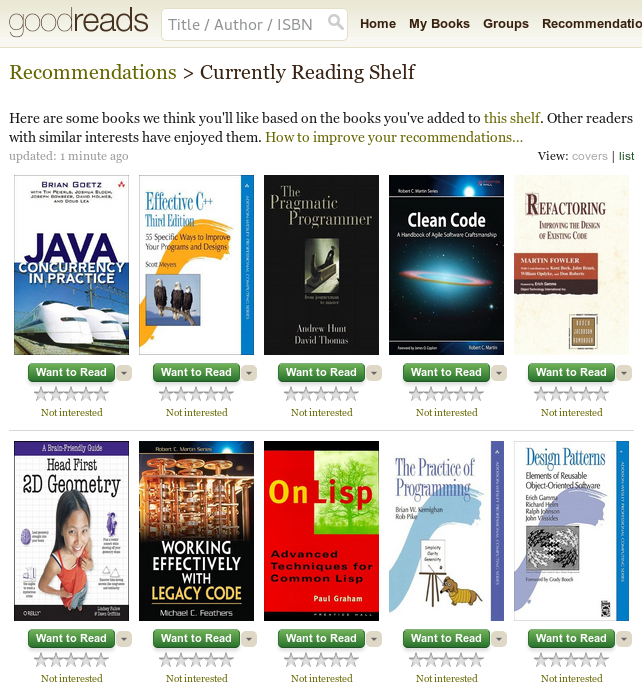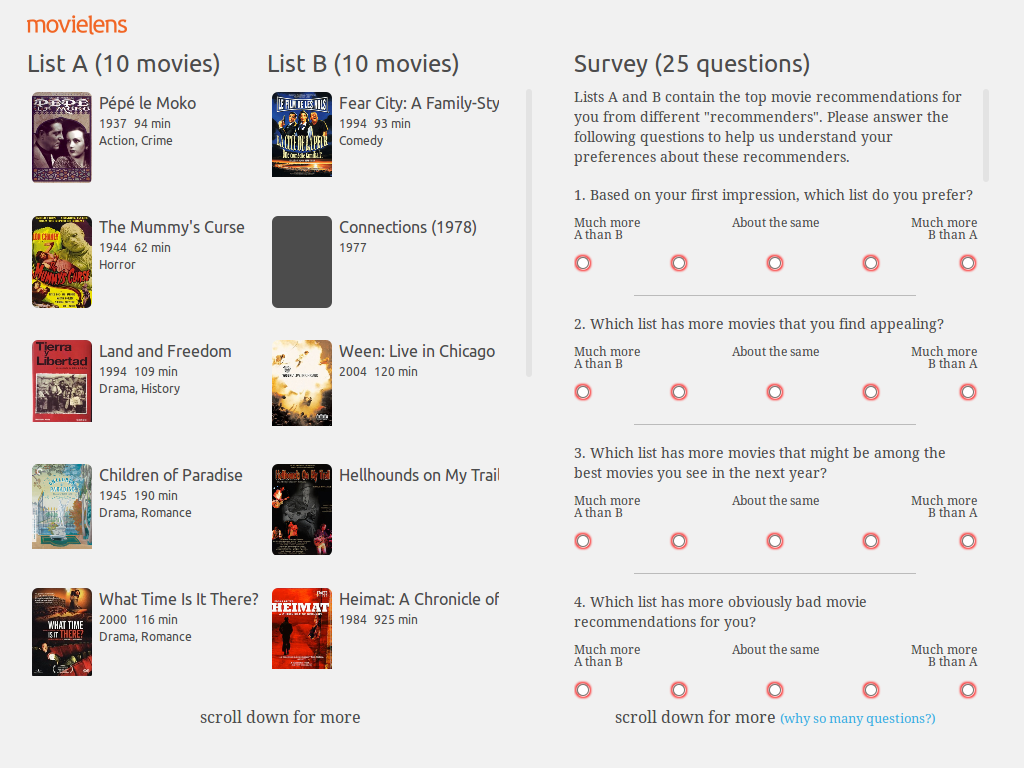Towards Recommender Engineering
Reproducible Research and Algorithm Personalities
Michael Ekstrand
GroupLens Research
Dept. of Computer Science and Engineering
University of Minnesota
GroupLens Research
Dept. of Computer Science and Engineering
University of Minnesota
Michael Ekstrand
B.S. CprE, Iowa State University (2007)
Finishing Ph.D CS, University of Minnesota (2014)
GroupLens Research (HCI & social computing)
Advised by Joseph Konstan and John Riedl
http://elehack.net
Research Overview
Helping users find, filter, navigate, and understand large-scale information spaces.
Topics
- Recommender systems
- Help search
- Wiki history browsing
- HPC network topology visualization
Methods
- Offline data analysis & experiments
- User studies
- System building
Current Research Objective
Recommender research should be
so we can engineer information solutions and understand recommender-assisted decision-making
Recent & Ongoing Work
Infrastructure
- LensKit toolkit
- Reproducible research
- Reproduce algorithms
- Deploy results
Experiments
- Offline w/ public data
- User studies
Overview
Overview
Recommender Systems

Recommender Systems
recommending items to users
Recommender Research
- Defined more by application than technology
- Existed as early as 1969 (Rich's Grundy)
- Modern form introduced in 1994 (Resnick et al.)
RecSys conference in 8th year, has ~300 attendees
- Mix of HCI, ML/IR, business
- Strong industrial presence
Common Approaches
Non-personalized
Content-based [Balabanović, 1997; others]
Collaborative filtering
- User-based [Resnick et al., 1994]
- Item-based [Sarwar et al., 2001]
- Matrix factorization [Sarwar et al., 2000; Funk, 2006]
Hybrid approaches [Burke, 2002]
Learning to Rank
Evaluating Recommenders
Many measurements:
- ML/IR-style data set experiments
- User studies
A/B testing
- Engagement metrics
- Business metrics
Common R&D Practice
- Develop recommender tech (algorithm, UI, etc.)
- Test on particular data/use case
- See if it is better than baseline
- Publish or deploy
Learned: is new tech better for target application?
Not learned: for what applications is new tech better? why?
Algorithms are Different
- Algorithms perform differently
- No reason to believe one size fits all
- Quantitatively similar algorithms can have qualitatively different results [McNee, 2006]
- Different algorithms make different errors [Ekstrand, 2012]
- Opportunity to tailor system to task
- Doesn't even count other system differences!
Building a Boat Shed
An Analogy
Current practice:
- build shed
- A/B test: roof with 2 different materials
- measure winter survival
- buy a new boat
Building a Boat Shed
An Analogy
Better practice
- compute span, snow load, etc.
- determine adequate roofing structure
- build boat shed
- enjoy the boat next summer
Recommender Engineering
Recommender engineering is
- designing and building a recommender system
- for a particular application
- from well-understood principles of algorithm behavior, application needs, and domain properties.
What Do We Need?
To enable recommender engineering, we to understand:
- Algorithm behaviors and characteristics
- Relevant properties of domains, use cases, etc. (applications)
- How these interactions affect suitability
All this needs to be reproduced, validated, and generalizable.
My work
- LensKit
enables reproducible research on wide variety of algorithms
- Offline experiments
- validate LensKit
- demonstrate algorithm differences
improve engineering
- User study
- obtain user judgements of algorithm differences
currently ongoing
Overview

LensKit is an open-source toolkit for building, researching, and studying recommender systems.
LensKit
- build
- prototype and study recommender applications
- research algorithms with users
deploy research results in live systems
- research
- reproduce and validate results
- new experiments with old algorithms
- make research easier
provide good baselines
- study
learn from production-grade implementations
LensKit Features
- Common APIs for recommender use cases
- Infrastructure for building and using algorithms
- Implementations of well-known algorithms
- Evaluation framework for offline data analysis
- Tools for working with algorithms, models, and configurations
LensKit Project
- Started in 2010
- Supported by undergraduate & graduate students, staff, etc.
- ~43K lines of Java (with some Groovy)
- Open source/free software under LGPLv2+
- Developed in public (GitHub, Travis CI)
- Competitors: Mahout, MyMediaLite, others
Design Challenges
We want:
- Flexibility (reconfigure to match and try many algorithm setups)
- Performance (so it works on real data with reasonable resources)
- Readability (so it can be understood)
Component Architecture
For flexibility and ease-of-use, we use:
- Modular algorithm designs
Automatic tooling for recommender components
- Practical configuration
- Efficient experimentation
- Easy web and database integration
Modular Algorithms
- Break algorithms into separate components where feasible
- Neighborhood finders
- Similarity functions
- Normalizers
- Anything else!
- Full recommender consists of many interoperating components
- Components specified with interfaces, implementations can be swapped out
Dependency Injection
Components receive their dependencies from whatever creates them.
public UserUserCF() {
similarity = new CosineSimilarity();
}public UserUserCF(SimilarityFunction sim) {
similarity = sim;
}A Little Problem
How do we instantiate this mess?

Dependency Injectors
- Extract dependencies from class definitions
- Instantiate required components automatically
Several of them in wide use:
- Spring
- Guice
- PicoContainer
DI Configuration
// use item-item CF to score items
bind ItemScorer to ItemItemScorer
// subtract baseline score from user ratings
bind UserVectorNormalizer
to BaselineSubtractingUserVectorNormalizer
// use user-item mean rating as baseline
bind (BaselineScorer, ItemScorer) to UserMeanItemScorer
bind (UserMeanBaseline, ItemScorer)
to ItemMeanRatingItemScorer
// the rest configured with defaultsGrapht
Existing containers have some limitations:
- Difficult to configure composed configurations
- Limited static analysis support
So we built Grapht:
- Easy context-sensitive configuration
- Pre-compute full dependency graph
Composable Components
Basic DI binds interfaces to implementations
What if same interface appears multiple times
- and you want different implementations?
- or different configs of same implementation?
Naturally arises in our domain
- wrapper components
- hybrid recommenders
Difficult to configure in existing systems
Context-Sensitive Policy
Context-Sensitive Policy
within (UserVectorNormalizer) {
bind (BaselineScorer, ItemScorer) to UserMeanItemScorer
}UserMeanItemScorerused when satisfying a dependency of aUserVectorNormalizer- Other baseline scorer dependencies unaffected
- Allows arbitrarily composable components
Context-Sensitive Policy
Surprisingly useful
- We created it to allow for configuring hybrids
- But it's a better solution for many other problems
Strictly more expressive than qualifiers
Static Dependency Graph
We compute the object graph before instantiating objects.
This allows us to
- analyze & debug configurations without building models
- automatically separate pre-built and runtime components
- reuse shared components in evaluator
Grapht Summary
To meet LensKit's needs, we created a new dependency injector that:
- Is built on a well-defined mathematical foundation (graph manipulation)
- Allows static analysis of component dependencies
- Enables arbitrarily composable components to be easily configured
Initial Results
RecSys 2011
- Reproduced comparisons & tunings of seminal algorithms
- Revisited previous best practices
- Discovered some new best practices
Asked: does rank-based evaluation affect design decisions?
- Not for simple choices
When Recommenders Fail
Short paper, RecSys 2012
Q1: Which algorithm has most successes (ε ≤ 0.5)?
Qn + 1: Which has most successes where 1…n failed?
| Algorithm | # Good | %Good | Cum. % Good |
|---|---|---|---|
| ItemItem | 1044371 | 52.23 | 52.23 |
| UserUser | 166008 | 8.30 | 60.53 |
| Lucene | 90018 | 4.50 | 65.03 |
| FunkSVD | 53313 | 2.67 | 67.70 |
| Mean | 21617 | 1.08 | 68.78 |
| Unexplained | 624291 | 31.22 | 100.00 |
Parameter Tuning
- Many algorithms have tunable parameters
- Usually tuned by grid search
- Very expensive
- Combinations often skipped
- Makes engineering search space huge
- Goal: reduce space and automate search
- Some results, still working on it
Outcomes of LensKit
- Public, open-source software now at version 2.0
- Basis for Coursera MOOC on recommender systems (~1000 students)
- Reproduced and extended various research results (RecSys 2011)
- New research results
- Recommender errors (RecSys 2012)
- Algorthmic analysis for interface research (Kluver et al., 2012; Nguyen et al., 2013)
- Implementation behind MovieLens and BookLens
- Used for CHI/CSCW Confer system
Overview
Context: MovieLens
- Movie recommendation service & community
- 2500–3000 unique users/month
- Extensive tagging features
User Study Goal
Advance recommender engineering by studying how users perceive the movie recommendations from different algorithms to differ.

Experiment Outcomes
- RQ1
Do users perceive movie lists from different algorithms to be different?
- RQ2
- How do they perceive these lists to be different?
Learn context-relevant properties for algorithms.
- RQ3
What characteristics predict their preference for one list over the other?
- Side Effect
Collect data for calibrating offline metrics.
Algorithms
Three well-known algorithms for recommendation:
- User-user CF
- Item-item CF
- Biased matrix factorization (FunkSVD)
Each user assigned 2 algorithms
Predictions
Predicted ratings influence list perception.
To control, 3 prediction treatments:
- Standard raw predictions (0.5–5 stars)
- No predictions
- Normalized predictions
Each user assigned 1 condition
Survey Design
Initial ‘which do you like better?’
25 questions
- ‘Which list has more movies that you find appealing?’
- ‘much more A than B’ to ‘much more B than A’
Final ‘which do you like better?’
Analysis features
- joint evaluation
- users compare 2 lists
- judgment-making different from separate eval
enables more subtle distinctions
- factor analysis
- 25 questions measure 5 factors
- more robust than single questions
structural equation model tests relationships
Structural Equation Model
List Properties
Secondary goal: identify measurable recommendation list properties that predict user judgements.
- Diversity
- Popularity
- Others
Outcomes:
- Understanding of features underlying user judgements
- Metrics for further offline analysis
Expected Contributions
User-perceived differences between 3 algorithms
Dimensions along which users perceive them to be different (5 factors)
Data set of user judgments of recommender differences
- feed back in to offline analysis
- calibrate offline metrics
Currently running with almost 300 completions.
Overview
Toward Recommender Engineering
The road to recommender engineering is long
- Extensive, validated research on algorithm characteristics
- Both offline and user studies
Carry on with my students and collaborators
- More user studies
- Informing offline analysis with user results
- Integrated into applications
Skills and Techniques
My research involves several major efforts:
- System building (and distribution)
- Offline data analysis
- User studies
- Interdisciplinary collaboration
Applications
This work
Future
Additional Directions
Interactive recommendation
- Recommend candidates, user accepts/rejects
- Recommender and user ‘work together’
- Recommenders as tools, not just agents
- Multi-algorithm systems
- Diversity and decision support
Discovery for decentralized communiation
Funding
NSF funded (IIS, HCC)
- GroupLens has had good success with NSF funding for recommender research
- Cyber infrastructure funding may be available
Medical could get NIH funding
Thank you!
Also thanks to
- GroupLens Research for amazing support
- NSF for funding research
- The Noun Project for great icons
- ‘Document’ by Rob Gill
- ‘Test Tube’ by Olivier Guin
- ‘Experiment’ by Icons Pusher
- ‘Future’ by Megan Sheehan
